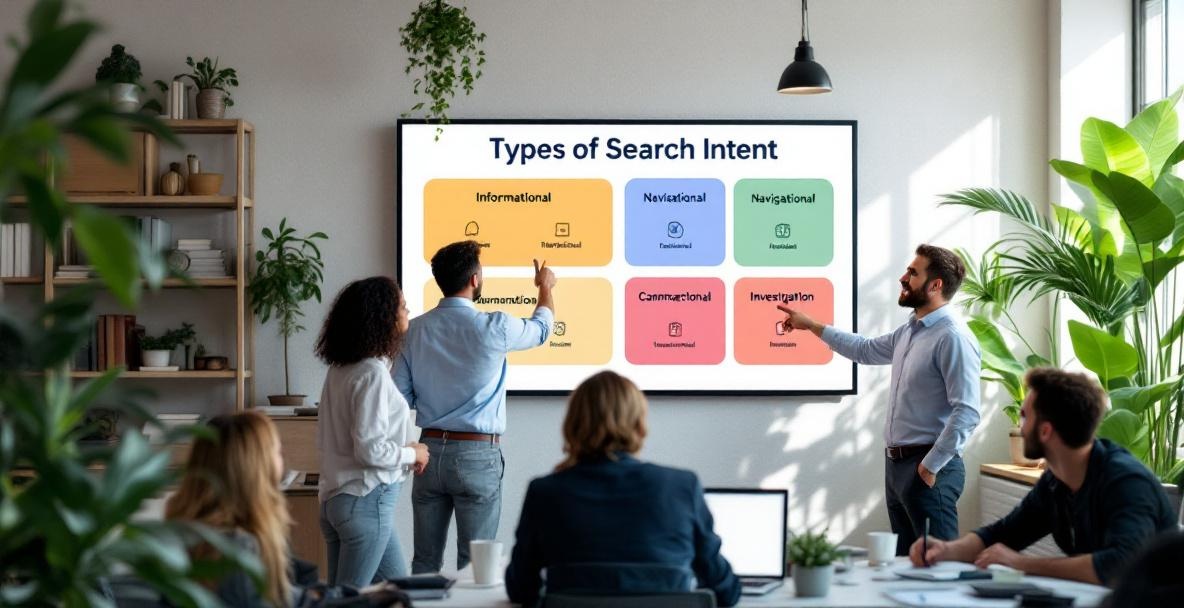When you know what people are really looking for, you can build content that truly connects. Understanding search intent means tuning into the real purpose behind every query. This approach can flip a simple page into a powerful tool that draws in readers and transforms them into loyal customers.
What Search Intent Means for Your Site

Search intent is simply the goal behind each search. When someone types a query, they are looking for something specific, and search engines now work hard to deliver the best match. If your content speaks directly to these needs, you earn better rankings, increased engagement, and more real results. When pages align with what readers expect, every click can become a step toward growing your audience.
If your page misses the mark and does not match what the visitor needs, the results can be disappointing. Even a detailed article may struggle if it doesn’t match the user's needs. For instance, imagine a search for "how to fix a leaky faucet" leading to a page that only promotes faucets rather than showing repair tips. That kind of disconnect stops your content from reaching its full potential.
Getting the Basics of Search Intent
It all boils down to asking why someone is searching. Instead of focusing just on keywords, consider the reader’s real motive behind the query. Are they looking to learn something new, find a particular site, compare a few options, or ready to make a purchase? Every scenario calls for a different kind of answer, so tailoring your approach is key.
Major search engines have spent a lot of time and money learning these details. Their advanced tools now spot what people are really after rather than just matching keywords. This means that your content must not only include the right words but also deliver on the promise of what the searcher wants, meeting their exact search goals.
The Pitfalls of Missing the Mark
When your content does not align with what readers are seeking, problems quickly unfold. First, your site may suffer from poor search rankings because the content does not truly match user needs. Next, even if your page shows up, visitors might leave almost immediately, causing high bounce rates and low engagement that hurt your overall performance.
Our team at SeoFlow has seen this over and over. Too often, pages are built around a company’s own goals instead of meeting what readers expect at that moment. This misstep can hold back even the best-crafted content from truly converting visitors into loyal customers.
Knowing the Different Kinds of Search Intent

Understanding the main types of search intent helps you choose the best way to present your content. Each kind demands its own format, depth of detail, and calls-to-action that really speak to what the reader needs.
When Readers Want to Learn Something
Sometimes, searchers are simply on a quest for knowledge. They type questions beginning with words like "how," "what," or "why" because they need to solve a problem or better understand a topic. They expect clear, helpful answers that walk them through the issue step by step.
For those curious minds, your page should be thorough and absolutely helpful. Articles, how-to guides, and even video tutorials work well for this purpose. For example, someone looking for "how to improve website SEO" will appreciate a page full of genuine, step-by-step advice rather than a hard sell.
Often, the first impression of your brand starts with informational content. By delivering clear answers and useful insights, you build trust that can lead readers back to your site when they are ready to take the next step.
When Visitors Are Looking for a Specific Spot
There are times when people search because they already know where they want to go. They may type in the name of a website or product because they are on a mission to find a particular page quickly. In these cases, the search acts like a shortcut.
If someone is hunting for your brand online, you need to make sure your site is easy to navigate and clearly shows who you are. Your homepage should appear when your brand name is searched, and individual product or service pages need to be easily found. These searches might not bring new readers, but they are vital for keeping your loyal customers happy.
When Visitors Are Ready to Act
Sometimes, the searcher is already set on taking action, whether it’s making a purchase, signing up for a service, or even downloading something. These searches come with words like "buy," "discount," or "deal," signaling that the visitor is near a decision.
For pages aimed at conversion, concentrate on providing clear product details, honest pricing information, and a smooth path to the next step. The goal is to highlight the benefits, ease any doubts, and guide your reader steadily toward a final action. A well-balanced page that mixes persuasion with clear facts can be the turning point between a lost click and a sale.
Comparing Options Before a Purchase
At times, people are still weighing their options. They search for reviews, comparisons, and detailed product features as part of their decision-making process. Words like "best," "top," or "compare" often appear in these queries.
When your audience is in this research phase, detailed comparisons, honest reviews, and clear highlight reels can really help. Side-by-side comparisons and customer testimonials sometimes make all the difference. By addressing worries head-on and showcasing what makes your offering truly stand out, you can guide potential buyers closer to a choice.
Matching Your Content to What Readers Want

To build pages that hit the mark, start with solid research and carry that focus through every step of writing and fine-tuning your content. A deliberate strategy ensures every word speaks to what your visitors expect, making your site a reliable resource for real-life solutions.
Tips for Digging into Keywords
Good keyword research is about more than just numbers. Look for clues in the phrases your audience uses. When you see words like "how to," "guide," or "tutorial," it’s a sign someone is looking to learn. Meanwhile, terms such as "buy," "cheap," or "deal" suggest a readiness to take action.
Take a close look at the search results for your important keywords. If you see mostly step-by-step guides, it points to an informational need, but if there are a lot of product pages, that means the audience is ready to purchase. These insights can inform how you shape your content to fit what readers really want.
Don’t forget to check out related searches and the "People also ask" sections. They provide extra context that helps you build a fuller picture of their journey.
Writing Content That Answers the Call
After you pinpoint what your audience truly needs, shape your content so it fits perfectly with that intent. For readers who want information, offer clear, complete answers. For those on the verge of purchasing, make sure pricing, offers, and next steps are easy to find.
Think about how you present your details. A detailed guide works wonders for curious readers, whereas a thorough product review can help someone ready to compare options. Custom templates for each type of intent can keep your message consistent and ensure every page hits its mark.
Learning from the Competition
Spend some time looking at what competitors are doing in the search results. Check the top-ranking pages for style, content length, and how they steer their readers to the next move. This research can shed light on what makes a successful page and help you fine-tune your own approach.
Notice the format and layout of these pages. Whether they are guides, product pages, or detailed reviews, every element of their structure gives you clues about what works. Remember, the goal is not to copy but to learn and shape your own approach so that you can stand out.
Finding the Clues: Tools and Techniques

Must-Have Tools
Sometimes the best insights come straight from the search engines. Look at Google’s results for your keywords, and you’ll see which pages perform best. Keep an eye on featured snippets and knowledge panels because they give you a clear idea of what readers are looking for.
Tools like SEMrush, Ahrefs, and Moz are incredibly helpful as they group keywords and even flag their intent. This makes it much easier to tailor your content right from the start and keep your strategy on track.
Consider using platforms that track ranking trends and identify intent patterns across many keywords. This type of automation can save you time and ensure your approach covers all the bases.
Methods to Gain Better Insights
Digging deeper through basic methods like SERP analysis can really boost your understanding. Check out the various formats of content that rank well, whether they are guides, product pages, or in-depth comparisons. This helps you see what works best in real situations.
Talking to your customers also gives you real feedback. Ask them what they expected to find when they searched, and you might uncover some eye-opening details about their needs. Tools like Google Analytics and Search Console can show you how people interact with your site; if visitors leave too quickly, it might be a hint that your content is off target, while high engagement means you’re on the right path.
Tweaking Your Content for Every Need
Sometimes all it takes is a little adjustment to boost your content. If an article isn’t performing as well, try adding more useful details, clear visuals, or practical examples. For pages aimed at selling products, including customer reviews and obvious benefits can make a big difference.
Make sure your content flows smoothly. Informative pages should feature neat headings and logical breaks, while pages designed to prompt action must include obvious pricing, strong calls-to-action, and trust signals that reassure the reader. Small tweaks here and there can help your page truly resonate with its intended audience.
Our experience at SeoFlow shows that small adjustments can make a big difference. Check out this insight on how aligning your content with reader needs can lift your rankings and boost engagement.
Wrapping It Up
Matching your content with what people are really searching for is the next step in evolving your SEO strategy. When you take the time to understand your audience’s true needs, you craft pages that satisfy both readers and search engines.
The Big Points
Remember, knowing search intent guides every part of your content creation-from the structure of your page to the calls-to-action you include. Whether someone is looking to learn, find a specific site, take action, or compare options, each purpose calls for its own tailored approach.
Your Next Moves
Start by reviewing your existing pages to see if they truly meet your readers’ expectations. Fix any gaps and focus on the pages with the most potential. Then, build a system that keeps search intent in mind every time you create new content.
Ready to transform your content strategy with search intent alignment? Try SeoFlow today to automatically analyze and optimize your content for perfect intent alignment. Our AI-powered platform identifies the exact intent behind your target keywords and helps create content that ranks higher, engages deeper, and converts better.




